
Jubaea is a genus of palms with one species, Jubaea chilensis, commonly known in English as the Chilean wine palm or Chile cocopalm, and palma chilena in Spanish. It is native to southwestern South America and is endemic to a small area of central Chile between 32°S and 35°S in southern Coquimbo, Valparaíso, Santiago, O'Higgins, and northern Maule regions.
Tiltil or Til-Til is a Chilean municipality and city, in the Chacabuco Province, Santiago Metropolitan Region. Tiltil is most known for being an execution place for rebels during Chile's independence war against Spain. Manuel Rodríguez was executed in Tiltil.

La Campana National Park is located in the Cordillera de la Costa, Quillota Province, in the Valparaíso Region of Chile. La Campana National Park and the Vizcachas Mountains lie northwest of Santiago. This national park covers approximately 80 square kilometres (31 sq mi) and is home to one of the last palm forests of Jubaea chilensis, which prehistorically had a much wider distribution than at present. Another attraction is the Cerro La Campana, which lends its name to the park. In 1834 Charles Darwin climbed this mountain, during the second voyage of HMS Beagle.
La Campana-Peñuelas is a Biosphere Reserve located in west-central Chile. which includes La Campana National Park and the Lago Peñuelas National Reserve. Forests within the La Campana-Peñuelas are habitats for the Chilean Wine Palm, Jubaea chilensis, an endangered palm, which had a much broader distribution prior to modern times.

Maytenus boaria (mayten) is an evergreen tree of the family Celastraceae, native from South America, up to 20 m (66 ft), 80 cm (31 in) diameter, straight trunk. It occurs naturally approximately from 30 to 50ºS: Chile.

The Paraguayan fat-tailed mouse opossum is a species of opossum in the family Didelphidae. It is found in forested areas of Brazil and Paraguay. It is known only from a few specimens. For two listed specimens, one had a head-and-body length of about 135 mm and a tail length of about 140 mm, while the other had a head-and-body length of about 120 mm and a tail length of about 155 mm. Most of its fur is gray, but the shoulder areas are reddish gray, and the ventral fur is pure white or creamy white. There is also a ring of black fur surrounding each eye. The ventral surface of the tail is white. The dorsal surface of the tail is gray for the first one third to one half of its length ; the remainder of the dorsal surface of the tail is white. The tail is hairless except for about its first ten mm. Although the genus Thylamys is characterized by fat storage in the tail, there is no evidence that this species stores fat in its tail.

The Chilean rock rat is a species of rodent in the family Octodontidae. It is found in the high Andes of Argentina and Chile.

Kageneckia oblonga is a species of plant in the family Rosaceae. It is endemic to Chile. K. oblonga is an evergreen tree. It grows from Coquimbo to Malleco. Example occurrences are found specifically found in central Chile within the La Campana National Park and Cerro La Campana forest areas. In these areas the endangered Chilean Wine Palm, Jubaea chilensis is an associated tree species.
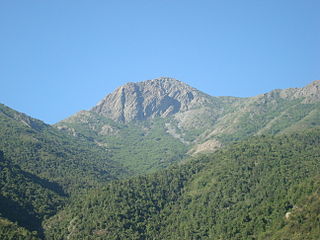
Cerro la Campana, the Bell mountain, is a mountain in La Campana National Park in central Chile. The Pacific and the mountain Aconcagua are visible from the summit on clear days.
The Vizcachas Mountains is a mountain range northwest of Santiago, in the Santiago Metropolitan Region, Chile. It is part of the Chilean Coast Ranges System.
The Ocoa Valley is a landform in central Chile located by the La Campana National Park. This valley is a locus where considerable archaeological recovery has taken place, yielding considerable finds of pre-European contact period. According to Dallman and Hogan, some of the greatest stands of the endangered Chilean Wine Palm, Jubaea chilensis are found on the slopes of La Campana that rise up from the Ocoa Valley.
Puya coquimbensis is a species in the family Bromeliaceae. This species is a rare plant found in certain portions of Chile including Punta Teatinos and Cerro La Campana. In La Campana National Park P.coquimbensis is associated with the endangered Chilean Wine Palm, Jubaea chilensis, which palm prehistorically had a much wider distribution.

Puya venusta is a species of flowering plant in the family Bromeliaceae. This species is a rare plant endemic to certain areas of Chile including Punta Teatinos and Cerro La Campana. In La Campana National Park, P. venusta is associated with the endangered Chilean Wine Palm, Jubaea chilensis, a palm that prehistorically had a significantly wider distribution.
Persea meyeniana is an evergreen tree or shrub in the laurel family (Lauraceae), native to central Chile. It belongs to the genus Persea, a group of evergreen trees that includes the avocado. It is threatened by habitat loss.
Cerro El Roble is a mountain in central Chile. Much of the land area associated with this mountain was incorporated into the La Campana National Park in the late 1990s. A station of the National Astronomical Observatory of Chile, Cerro El Roble Observatory is located at the top of this mountain.
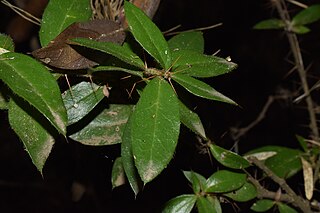
Dasyphyllum excelsum is a species of flowering plant in the family Asteraceae. This species is endemic to Chile, occurring from Quillota to Cauquenes between 190 and 800 m above sea level, a specific location of occurrence being in central Chile within the Cerro La Campana forests in association with the endangered Chilean wine palm, Jubaea chilensis.
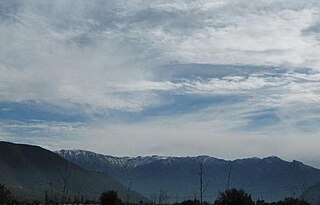
Chicauma is a mountain range in central Chile. This locale is noted for the impact of a large meteor noted in a report from 1916. The range is also termed Alto de Chicauma or Sierra de Chicauma. A portion of the Chicauma has been added to the La Campana National Park.
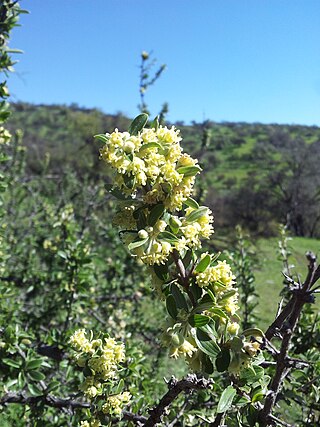
Trevoa is a genus of actinorhizal plants; these dicotyledon flora are trees or small shrubs. The genus was first proposed by Miers in 1825, but was not fully described until 1830 by Sir William Jackson Hooker. Genus members are notable for their ability to fix nitrogen. Species of this genus are generally found in the near coastal forests and arid shrubland of South America. Some species are localized in the mountains of central Chile; for example, the species Trevoa trinervis occurs in the La Campana National Park and other proximate areas of central Chile.
Retanilla trinervia is a species of actinorhizal plant within the family Rhamnaceae; this dicotyledon flora is a shrub or small tree. R. trinervia is notable for its ability to fix nitrogen. This species mainly occurs in the near coastal forests and arid shrubland of Chile. Example occurrences are found in the mountains of central Chile; for example, it occurs in the La Campana National Park in association with Acacia caven and Jubaea chilensis. as well as other proximate areas of central Chile.
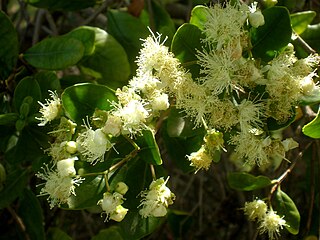
Myrceugenia exsucca is an evergreen woody flowering plant species of the Myrtle family, Myrtaceae. The species is native to South America as far south as Chile. An example occurrence is in central Chile within the La Campana National Park. A common name for this tree is petra.












